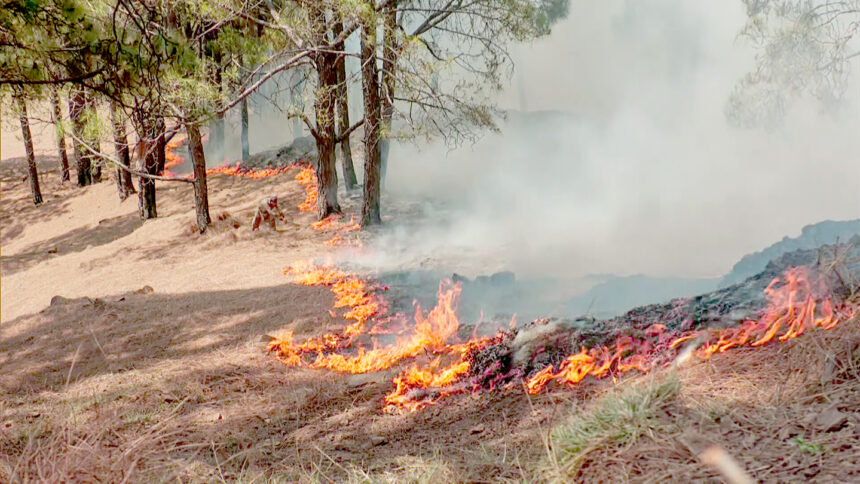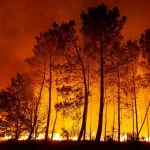Srinagar, Feb 17: Jammu and Kashmir has witnessed a concerning rise in forest fires, with over two dozen incidents reported in the past two months, driven by an ongoing dry spell. The extended lack of precipitation has raised alarms among forest officials, who warn that the risk of further wildfires could increase in the coming weeks.
According to officials from the J&K Forest Department, the unusually dry weather, coupled with strong winds, has created an environment primed for wildfires. A number of these incidents have occurred in forested areas of Tral, Udhampur, Reasi, Poonch, and other regions.
Forest fires are typically common in the sub-tropical forests of the Jammu region, while their intensity and frequency are generally lower in the Kashmir region. However, due to global climate changes, factors such as irregular winter precipitation, dry autumns, and spring seasons have created favorable conditions for forest fires in the valley as well.
Suresh Kumar Gupta, Principal Chief Conservator of Forests (PCCF) and Head of Forest Force (HoFF) for Jammu and Kashmir, highlighted the vulnerability of the region’s forests due to the ongoing dry spell. “The absence of rain and snowfall has left the forests dry and highly susceptible to fires. Even a small spark can lead to a devastating wildfire,” he said. “We are on high alert and have mobilized fire-fighting teams to contain these fires.”
Gupta also emphasized the environmental toll of these fires. “This is a serious environmental crisis. If the dry spell continues, we may witness an unprecedented rise in wildfires. These fires are not only destroying valuable green cover but also contributing to increased air pollution and soil degradation.”
In response to the growing risk, authorities are urging the public to remain vigilant and report any fire incidents immediately. The Forest Department has ramped up surveillance efforts and is coordinating with local disaster response teams to mitigate potential risks.
“We urge people to avoid activities like burning dry grass or discarding cigarette butts in forested areas. Our teams are doing their best, but public cooperation is crucial in preventing these fires,” officials said.
Dr. Avinash Kumar, a faculty member at the University of Jammu, spoke with Rising Kashmir about the importance of implementing preventive measures. “To avoid forest fires, it’s essential to strictly regulate human activities that pose fire risks. Educating campers and hikers about fully extinguishing campfires, avoiding smoking in forest areas, and properly disposing of flammable materials is key,” he explained.
Kumar also suggested that authorities should enforce stricter regulations on open fires and increase monitoring of high-risk areas, particularly during dry seasons. “Installing and maintaining firebreaks—gaps in vegetation that help prevent fires from spreading—can significantly reduce the risk of uncontrollable fires,” he added.
Jammu and Kashmir has a total forest area of 20,230 square kilometers, making up roughly 19.95% of the region’s total geographical area of 101,387 square kilometers. The forested land is divided into 2,551 square kilometers of reserved forests, 17,643 square kilometers of protected forests, and 36 square kilometers of unclassified forests.
Another environmental expert, Dr. Mustafa Khan, emphasized the importance of proactive forest management. “Regular removal of dead trees, dry leaves, and other combustible materials through controlled burns or mechanical thinning is vital to maintaining forest health while minimizing fire risks,” he said. Khan also advocated for public awareness campaigns to educate communities about fire safety and encourage participation in reporting potential fire hazards.
Khan further stressed the need for collaboration between local communities, government agencies, and environmental organizations to create and implement effective forest fire prevention plans.
According to the latest India State of Forest Report 2023 (ISFR 2023), J&K leads all states and Union Territories with the highest growing stock at 296.22 Cum/ha, followed by Himachal Pradesh at 219.46 Cum/ha. J&K also has the highest carbon stock per hectare at 174.10 tons among UTs, and the region has increased its forest cover by 34.78 square kilometers.
Under the J&K Green Drive and campaigns such as Ek Ped Shahidon Ke Naam and Ek Ped Maa Ke Naam, the Department has set a target of planting 15 million saplings. Additionally, it aims to plant 10 million more saplings through various afforestation campaigns, including those under Capex and CAMPA.
Currently, 290 forest nurseries maintained by the department have a total stock of 290.19 lakh saplings, of which 114.98 lakh are ready for plantation.
Unprecedented forest fires threaten Kashmir’s green cover due to dry spell
• Dept sets target of planting 150 lakhs of saplings this season: Officials

Leave a Comment Leave a Comment







